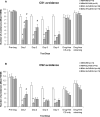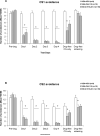Clozapine, but not olanzapine, disrupts conditioned avoidance response in rats by antagonizing 5-HT2A/2C receptors
- PMID: 21986871
- PMCID: PMC3275656
- DOI: 10.1007/s00702-011-0722-6
Clozapine, but not olanzapine, disrupts conditioned avoidance response in rats by antagonizing 5-HT2A/2C receptors
Abstract
The present study was designed to assess the role of 5-HT(2A/2C) receptors in the acute and repeated effect of clozapine and olanzapine in a rat conditioned avoidance response model, a validated model of antipsychotic activity. Male Sprague-Dawley rats that were previously treated with either phencyclidine (0.5-2.0 mg/kg, sc), amphetamine (1.25-5.0 mg/kg, sc), or saline and tested in a prepulse inhibition of acoustic startle study were used. They were first trained to acquire avoidance response to a white noise (CS1) and a pure tone (CS2) that differed in their ability to predict the occurrence of footshock. Those who acquired avoidance response were administered with clozapine (10.0 mg/kg, sc) or olanzapine (1.0 mg/kg, sc) together with either saline or 1-2,5-dimethoxy-4-iodo-amphetamine (DOI, a selective 5-HT(2A/2C) agonist, 1.0 or 2.5 mg/kg, sc), and their conditioned avoidance responses were tested for four consecutive days. After two drug-free retraining days, the long-term repeated effect was assessed in a challenge test during which all rats were injected with a low dose of clozapine (5 mg/kg, sc) or olanzapine (0.5 mg/kg). Results show that pretreatment of DOI dose-dependently reversed the acute disruptive effect of clozapine on both CS1 and CS2 avoidance responses, whereas it had little effect in reversing the acute effect of olanzapine. On the challenge test, pretreatment of DOI did not alter the clozapine-induced tolerance or the olanzapine-induced sensitization effect. These results confirmed our previous findings and suggest that clozapine, but not olanzapine, acts on through 5-HT(2A/2C) receptors to achieve its acute avoidance disruptive effect and likely its therapeutic effects. The long-term clozapine tolerance and olanzapine sensitization effects appear to be mediated by non-5-HT(2A/2C) receptors.
Figures




Similar articles
-
Repeated asenapine treatment produces a sensitization effect in two preclinical tests of antipsychotic activity.Neuropharmacology. 2013 Dec;75:356-64. doi: 10.1016/j.neuropharm.2013.05.031. Epub 2013 Aug 14. Neuropharmacology. 2013. PMID: 23954676 Free PMC article.
-
Distinct neural mechanisms underlying acute and repeated administration of antipsychotic drugs in rat avoidance conditioning.Psychopharmacology (Berl). 2010 Sep;212(1):45-57. doi: 10.1007/s00213-010-1925-5. Epub 2010 Jul 10. Psychopharmacology (Berl). 2010. PMID: 20623111 Free PMC article.
-
Effects of central activation of serotonin 5-HT2A/2C or dopamine D 2/3 receptors on the acute and repeated effects of clozapine in the conditioned avoidance response test.Psychopharmacology (Berl). 2015 Apr;232(7):1219-30. doi: 10.1007/s00213-014-3756-2. Epub 2014 Oct 7. Psychopharmacology (Berl). 2015. PMID: 25288514 Free PMC article.
-
Long-term impacts of adolescent risperidone treatment on behavioral responsiveness to olanzapine and clozapine in adulthood.Prog Neuropsychopharmacol Biol Psychiatry. 2014 Jan 3;48:177-85. doi: 10.1016/j.pnpbp.2013.10.005. Epub 2013 Oct 16. Prog Neuropsychopharmacol Biol Psychiatry. 2014. PMID: 24140929 Free PMC article.
-
Behavioral pharmacology of olanzapine: a novel antipsychotic drug.J Clin Psychiatry. 1997;58 Suppl 10:37-44. J Clin Psychiatry. 1997. PMID: 9265915 Review.
Cited by
-
Repeated administration of aripiprazole produces a sensitization effect in the suppression of avoidance responding and phencyclidine-induced hyperlocomotion and increases D2 receptor-mediated behavioral function.J Psychopharmacol. 2015 Apr;29(4):390-400. doi: 10.1177/0269881114565937. Epub 2015 Jan 13. J Psychopharmacol. 2015. PMID: 25586399 Free PMC article.
-
Repeated asenapine treatment produces a sensitization effect in two preclinical tests of antipsychotic activity.Neuropharmacology. 2013 Dec;75:356-64. doi: 10.1016/j.neuropharm.2013.05.031. Epub 2013 Aug 14. Neuropharmacology. 2013. PMID: 23954676 Free PMC article.
-
Time-dependence of risperidone and asenapine sensitization and associated D2 receptor mechanism.Behav Brain Res. 2013 Nov 15;257:286-94. doi: 10.1016/j.bbr.2013.09.050. Epub 2013 Oct 5. Behav Brain Res. 2013. PMID: 24103641 Free PMC article.
-
Environmental and behavioral controls of the expression of clozapine tolerance: evidence from a novel across-model transfer paradigm.Behav Brain Res. 2013 Feb 1;238:178-87. doi: 10.1016/j.bbr.2012.10.009. Epub 2012 Oct 23. Behav Brain Res. 2013. PMID: 23092709 Free PMC article.
-
Avoidance disruptive effect of clozapine and olanzapine is potentiated by increasing the test trials: further test of the motivational salience hypothesis.Pharmacol Biochem Behav. 2013 Jan;103(3):467-73. doi: 10.1016/j.pbb.2012.09.013. Epub 2012 Sep 28. Pharmacol Biochem Behav. 2013. PMID: 23026062 Free PMC article.
References
-
- Ader R, Clink DW. Effects of chlorpromazine on the acquisition and extinction of an avoidance response in the rat. J Pharmacol Exp Ther. 1957;131:144–148. - PubMed
-
- Arnt J. Pharmacological specificity of conditioned avoidance response inhibition in rats: inhibition by neuroleptics and correlation to dopamine receptor blockade. Acta Pharmacol Toxicol (Copenh) 1982;51:321–329. - PubMed
-
- Atkins JB, Chlan-Fourney J, Nye HE, Hiroi N, Carlezon WA, Jr, Nestler EJ. Region-specific induction of deltaFosB by repeated administration of typical versus atypical antipsychotic drugs. Synapse. 1999;33:118–128. - PubMed
-
- Barrett JE. The emergence of behavioral pharmacology. Mol Interv. 2002;2:470–475. - PubMed
-
- Barrett JE, Bergman J. Peter B. Dews and pharmacological studies on behavior. J Pharmacol Exp Ther. 2008;326:683–690. - PubMed
Publication types
MeSH terms
Substances
Grants and funding
LinkOut - more resources
Full Text Sources
Miscellaneous

